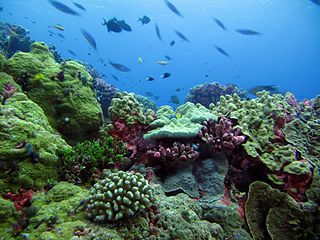Craugastor lineatus, also known as the Montane robber frog, is a critically endangered frog in the family Craugastoridae. It is native to Guatemala and southern Mexico. It lives in lower montane evergreen forests. This is a critically endangered species which has experienced a rapid population decline, probably as a result of the effects of chytridiomycosis.
Craugastor alfredi is a species of frog in the Craugastoridae family. It is found in Guatemala and Mexico. Its natural habitat is subtropical or tropical moist lowland forests. It is threatened by habitat loss. Many populations are attracted to living in or near cave entrances, due to orthopterans and other food sources. They are categorized by having truncated digital pads on their two outer fingers and each fifth toe extends longer than the third. A subspecies of Craugastor alfredi was recently discovered in the Honduras called Craugastor cyanochthebius.
Craugastor anciano is a species of frog in the Craugastoridae family. It is endemic to the Cordillera de Celaque in Honduras. Its natural habitats are premontane and lower montane moist forests. It lives on the ground along streams.
The Rana De Hojarasca is a species of frog in the Craugastoridae family. It is endemic to Costa Rica. Its natural habitats are subtropical or tropical moist montane forests and rivers.
Craugastor coffeus is a species of frog in the family Craugastoridae. It is found in Honduras and possibly Guatemala. Its natural habitats are subtropical or tropical moist montane forests and plantations . It is threatened by habitat loss.
Craugastor cruzi is a species of frog in the family Craugastoridae. It is endemic to Honduras. Its natural habitats are subtropical or tropical moist montane forests and intermittent rivers.
Craugastor fecundus is a species of frog in the family Craugastoridae. It is endemic to Honduras. Its natural habitats are subtropical or tropical moist lowland forests, subtropical or tropical moist montane forests, and rivers. It is threatened by habitat loss.
Craugastor gulosus is a species of frog in the family Craugastoridae. It is found in Costa Rica and Panama. Its natural habitat is subtropical or tropical moist montane forests. It is threatened by habitat loss.
Craugastor melanostictus is a species of frog in the family Craugastoridae. It is found in Costa Rica and Panama. Its natural habitat is subtropical or tropical moist montane forests. It is threatened by habitat loss.
Craugastor mexicanus is a species of frog in the family Craugastoridae. It is endemic to Mexico. Its natural habitat is subtropical or tropical moist montane forests. It is threatened by habitat loss.
Craugastor omoaensis is a species of frog in the family Craugastoridae. It is endemic to Honduras and also is one of 13 species of amphibians and reptiles that are endemic to the Sierra de Omoa. It is known from only 24 specimens studied. Its natural habitats are subtropical or tropical moist montane forests, rivers, and intermittent rivers.
Craugastor polymniae is a species of frog in the family Craugastoridae. It is endemic to Mexico. Its natural habitat is subtropical or tropical moist montane forests. It is threatened by habitat loss.
Craugastor pygmaeus is a species of frog in the family Craugastoridae. It is found in Guatemala and Mexico. Its natural habitats are subtropical or tropical moist lowland forests and subtropical or tropical moist montane forests. It is threatened by habitat loss.

Craugastor raniformis is a species of frog in the family Craugastoridae. It is found in Colombia and Panama. It is a reasonably common species found in humid lowland and montane forests up to 1,500 m (4,900 ft) asl. It is also common in wet pastureland. Furthermore, it is one of the dominant frogs in abandoned mixed farming areas in the coastal Pacific rainforests in Colombia. This adaptable species is not considered threatened.

Craugastor rhodopis, also known as the polymorphic robber frog, is a species of frog in the family Craugastoridae. It is endemic to Mexico and known from isolated high-elevation populations in western Veracruz and adjacent Hidalgo and Puebla states, and apparently disjunctly, from central and southeastern Chiapas and adjacent Oaxaca. Its natural habitat is tropical montane forest. It is threatened by habitat loss.
Craugastor sartori, also known as the Chiapas dwarf robber frog, is a species of frog in the family Craugastoridae. It is endemic to Mexico and known from the Sierra Madre de Chiapas in the vicinity of Cerro Ovando, at elevations of about 1,200–1,900 m (3,900–6,200 ft) asl. Its natural habitats are montane cloud and mixed forests. It is threatened by habitat loss caused by particularly logging.
Craugastor emleni is a species of frog in the family Craugastoridae. It is endemic to Honduras. Its natural habitats are subtropical or tropical moist montane forests, rivers, and plantations.
Craugastor olanchano is a species of frog in the family Craugastoridae. It is endemic to Honduras. Its natural habitats are subtropical or tropical moist montane forests and rivers.
Craugastor vulcani is a species of frog in the family Craugastoridae. It is endemic to the Sierra de los Tuxtlas range in southern Veracruz state, Mexico. Its name refers to its type locality on the San Martin Tuxtla volcano. Its natural habitats are premontane and lower montane wet forests where it occurs along streams. The species is likely impacted by habitat loss, and its distribution area is small, prompting classification as an endangered species.
Craugastor sandersoni is a species of frog in the family Craugastoridae. It is found in Belize and eastern Guatemala, in the Maya Mountains, Sierra de Santa Cruz, Sierra del Mico and the eastern part of the Sierra de las Minas. Its natural habitats are subtropical or tropical moist lowland forests and wetlands, from sea level to 1,160 m asl. It is threatened by habitat loss.








